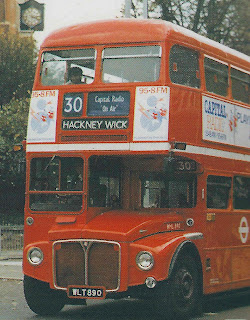Cobham Bus Museum's Open Days have had their fair share of extreme weather events. I think it was 1977 when it was so wet we had no power. In 2008 it snowed even though it was April, and today, at the "Farewell Redhill Road" event, it rained reasonably steadily all day.
Nevertheless several hundred people came to see the inside (and outside!) of this famous building for the last time and patiently queued for vintage bus rides to Stoke D”Abernon (where a further display was provided) and to Weybridge Station.
The first Open Days weren’t quite like this – the bus service was run on an ‘ad hoc’ basis with vehicles and drivers pressed into service as demand required. I can well recall running between the Museum and Weybridge Station not knowing for how long it would be for.
In due course the services became more prolific and were scheduled in great detail. If visitors queued whilst numerous buses and crews were in evidence waiting for their booked times then they were indeed experiencing London Transport of the 1960s.
The Museum is closing and moving to brand new premises inside the Brooklands site where it will be alongside numerous other exhibits including Concorde.
There are mixed feelings about the move. The Redhill Road site has been occupied by buses since 1972 thanks to the pioneering efforts of the bus preservation pioneers of the time and especially due to the personal contribution and sacrifices of Don and the late Alan Allmey.
The building was one of three hastily constructed during World War II and was a ‘temporary structure’. It has its own place in history as part of the Vickers Works’ efforts during the war. Not surprisingly, the building is now time-expired and the site itself sits in the middle of a very affluent Weybridge suburb.
It was a place where bus owners could come and get help, enjoyment and secure facilities. There are those who regret its passing as the new Museum will be much more visitor orientated as it will, for the first time, now be open every day and not just on a few.
However, sitting inside what is already a popular venue, it will reach a much wider audience which is of course that is what we are doing this for - to make it possible for people to see these wonderfully-preserved items from our past. By amazing luck it is only a short distance from its old home, so hopefully it will still be a magnet for volunteer members.
I have already had a visit to the site of the new Museum where construction is shortly to commence. I must admit to having my back to the wilderness which is to become the new Museum as my attention was completely taken by the splendid Vickers Vanguard which is parked alongside – one of those I saw whenever I stood on the Spectator Area platform on the Queen’s Building at London Airport……
As I imagined again the unmistakable smell of propeller aircraft aviation fuel from that very terrace I remember drifting across to the small bookshop and found a small paperback book by Ian Allan on London Transport buses – the first I’d ever seen.
That’s interesting I thought…..little did I know where THAT would lead!
T792 was a resident at Cobham for all of the years I was involved and has now been restored to an extremely high standard and lives elsewhere. However it came back for today's event.
And the Vanguard which will be the Museum's nearest neighbour.
....








